2112 ROADTEST: HINO FY2PUKA
Page 40
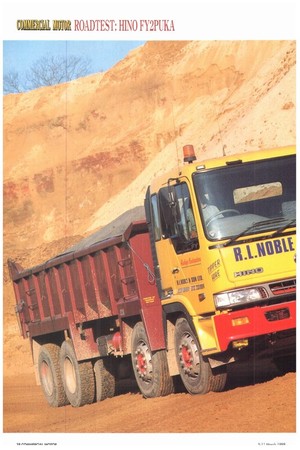
Page 41
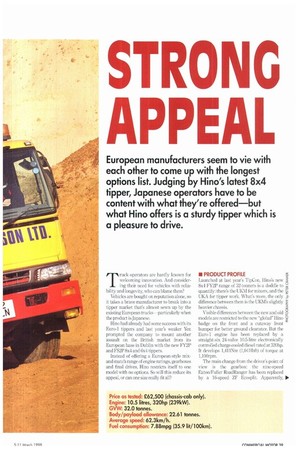
Page 42
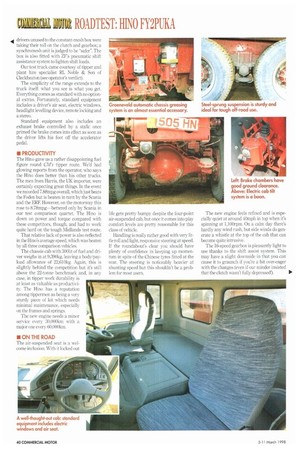
Page 44
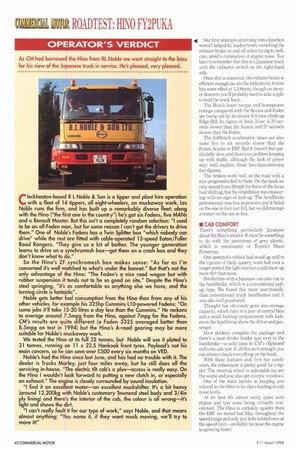
Page 45

Page 43
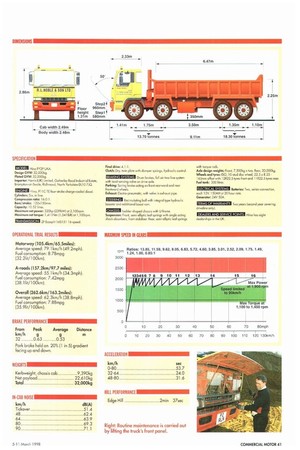
If you've noticed an error in this article please click here to report it so we can fix it.
STRONG
APPEAL
European manufacturers seem to vie with each other to come up with the longest options list. Judging by Hino's latest 8x4 tipper, Japanese operators have to be content with what they're offered—but what Hino offers is a sturdy tipper which is a pleasure to drive.
Truck operators are hardly known for welcoming innovation„A.nd considering their need for vehicles with reliability and longevity, who can blame them?
Vehicles are bought on reputation alone, so it takes a brave manufacturer to break into a tipper market that's almost sewn up by the existing European trucksparticularly when the product is Japanese.
Hino had already had some success with its Euro-1 tippers and last year's weaker Yen prompted the company to mount another assault on the British market from its European base in Dublin with the new FY2P and FS2P 8x4 and 6x4 tippers.
Instead of offering a European-style mixand-match range of engine ratings, gearboxes and final drives, Hino restricts itself to one model with no options. So will this reduce its appeal, or can one size really fit all? • PRODUCT PROFILE Launched at last year's TipCon, I lino's new 8x4 FY2P range of 32-tormers is a doddle to quantify: there's the l:KM for mixers, and the UKA for tipper work. What's more, the only difference between them is the U1(141's slightly heavier chassis.
Visible differences between the new and old p models are restricted to the new "global" Hino 2 badge on the front and a cutaway front bumper for better ground clearance. But the Euro-1 engine has been replaced by a straight-six 24-valve 10.5-litre electronically controlled charge-cooled diesel rated at 320hp. It develops 1,111Nni (1,011Ibft) of torque at 1,10Orpm.
The main change from the driver's point of view is the gearbox: the nine-speed Eaton/Fuller RoadRanger has been replaced by a 16-speed ZF Ecosplit. Apparently, Ili drivers unused to the constant-mesh box were taking their toll on the clutch and gearbox; a synchromesh unit is judged to be "safer". The box is also fitted with ZF's pneumatic shift assistance system to lighten shift toads.
Our test truck came courtesy of tipper and plant hire specialist RL Noble & Son of Cleckheaton (see operator's verdict).
The simplicity of the range extends to the truck itself: what you see is what you get. Everything comes as standard with no optional extras. Fortunately, standard equipment includes a driver's air seat, electric windows, headlight levelling device, remote locking and a stereo.
Standard equipment also includes an exhaust brake controlled by a stalk: once primed the brake comes into effect as soon as the driver lifts his foot off the accelerator pedal • PRODUCTIVITY The Hino gave us a rather disappointing fuel figure round C11/1"s tipper route. We'd had glowing reports from the operator, who says the Hino does better than his other trucks. The men from Harris, the UK importer, were certainly expecting great things. In the event we recorded 7.88mpg overall, which just beats the Foden but is beaten in turn by the Scania and the ERR However, on the motorway this rose to 8.78mpg—bettered only by Scania in our test comparison quartet. The Hino is down on power and torque compared with these competitors, though, and had to work quite hard on the tough Midlands test route.
That relative lack of power is also reflected in the Hino's average speed, which was beaten by all three comparison vehicles.
The chassis-cab with 300lit of fuel and driver weighs in at 9,390kg, leaving a body/payload allowance of 22,610kg. Again, this is slightly behind the competition but it's still above the 22-tonne benchmark and, in any case, in tipper work durability is at least as valuable as productivity. The Hino has a reputation among tippermen as being a very sturdy piece of kit which needs minimal maintenance. especially on the frames and springs.
The new engine needs a minor service every 30.000km with a major one every 50,000km.
• ON THE ROAD
The air-suspended seat is a welcome inclusion. With it locked out life gets pretty bumpy despite the four-point air-suspended cab, hut once it comes into play comfort levels are pretty reasonable for this class of vehicle.
Handling is really rather good with very little roll and light, responsive steering at speed. If the roundabout's clear you should have plenty of confidence in keeping up momentum in spite of the Chinese tyres fitted at the rear. The steering is noticeably heavier at shunting speed but this shouldn't be a problem for most users. The new engine feels refined and is especially quiet at around 40mph in top when it's spinning at 1,100rpm. On a calm day there's hardly any wind rush, but side winds do generate a whistle at the top of the cab that can become quite intrusive.
The 16-speed gearbox is pleasantly light to use thanks to the shift assist system. This may have a slight downside in that you can cause it to graunch if you're a bit over-eager with the changes (even if our minder insisted that the clutch wasn't fully depressed?). Our first attempts at turning into a junction weren't helped by inadvertently switching the exhaust brake on and off when trying to indicate, amid a commotion of engine noise. You have to remember that this is a Japanese truck with the indicator switch on the right-hand side.
Once this is mastered, the exhaust brake is efficient enough (as are the indicators); it even has some effect at 1,100rpm, though on steeper descents you'll probably need to take a split to hold the truck back.
The Hino's lower torque and horsepower ratings compared with the Scania and Foden are borne out by its slower hill time climb up Edge Hill. Its figure of 2min 37sec is 10 seconds slower than the Scania and 27 seconds slower than the Foden.
The 0-80km/h acceleration times are also some five to six seconds slower than the Foden, Scania or ERF. But it doesn't feel particularly slow, and there's no problem keeping up with traffic, although the lack of power may well explain those less-than-stunning fuel figures.
The brakes work well on the road with a nice progressive feel to them. On the track we only tested from 20mph for fears of the loose load shifting, but the retardation was reassuring with no sign of lock-up. The handbrake performance was less impressive and it failed on the one-in-four test hill, but we did manage a restart on the one-in-five.
• CAB COMFORT There's something particularly Japanese about the Hino's interior. It must be something to do with the panorama of grey plastic, which is reminiscent of Toyota's Hiace Powervan.
Our operator's vehicle had stood up well to the rigours of daily quarry work but over a longer period the light interior could show up more dirt than most.
Similarities with a Japanese van also run to the handbrake, which is a conventional pullup type. We found this more user-friendly than conventional truck handbrakes and it was also well positioned.
Thought has obviously gone into storage capacity, which runs to a pair of central bins and a small locking compartment with lockers in the headlining above the driver and passenger.
Door pockets complete the package and there's a neat drinks holder just next to the handbrake—a solid pass in CM'S clipboard and coke can test. If all tins isn't enough, you can always chuck everything on the bunk.
With these features and firm but comfy seats, the refinement is pretty good for a tipper. The steering wheel is adjustable (as are the seats) and you also get electric windows.
One of the main factors in keeping you relaxed in the Hino is its class-leading in-cab noise levels.
At its best it's almost eerily quiet with engine and tyre noise being virtually nonexistent. The Hino is certainly quieter than the ERF we tested last May throughout the speed range and only just falls behind once at the speed limit—probably because the engine is spinning faster. • SUMMARY In terms of driver appeal the Hino has a lot going for it. We spent an enjoyable two days driving round the Midlands and, considering the route's a tough one, that's saying something. This is mostly down to the lightness of the controls; particularly the ZF gearbox.
Handling is also exemplary and the ride isn't bad in its class. The cab is also comfortable with a good level of features as standard.
If payload isn't at the top of your wish list you'll appreciate the sturdy build quality and the Hino's enviable reputation for reliability And now back to fuel. Yes, the figure is a bit disappointing but it's by no means a disaster and the ease of driving may well compensate for this, particularly in a fleet where drivers are constantly swapping vehicles.
A choice of power ratings/gearboxes/final drives might improve the fuel scenario, but if Hino sticks to its one-size-fits-all policy we're sure there will be plenty of customers to match the profile.
-I by Charles Young Price as tested: £62,500 (chassis-cab only). Engine: 10.5 litres, 320hp (239kW).
GVW: 32.0 tonnes.
Body/payload allowance: 22.61 tonnes. Average speed: 62.3km/h. Fuel consumption: 7.88mpg (35.9 lit/100km).
SPECIFICATION
MEM Hino FY2P UKA,
Design GVW: 32,000kg.
Plated GVW: 32,000kg, Importer: Harris IUK) Limited, Gather* Rood Industrial Estate, Brampton-an-Swale, Richmond, North Yorkshire 0110 7JO.
BE= t-lino, PI I C-TE four-stroke charge-cooled diesel Cylinders: Six, in line.
Compression ratio: 16.0:1.
Bore/stroke: 122x I 50mm.
Capacity: 10 57 litres.
Maximum net power: 320hp (239kW) at 2,100rpm.
Maximum net torque: 1,411Nrn 11,0411bft) at 1,10Orpm.
TRANSMISSION: ZF Ecosplit 165151 16-speed. Final drive: 4.1:1.
Clutch: Dry, twirl pinto with damper springs, hydraulic control.
Drum brakes, full air hvo-line system with load-sensing valve on drive axle, Parking: Spring brake acting on front rearward and rear frontward wheels.
Exhaust: Electro-pneurnatic, with valve in exhaust pipe. BRAKING SYSTEMS: STEERING Recirculating boll with integral type hydraulic booster and additional boost ram.
MEM Ladder-shaped chassis with LI-frame. Suspension: Front, semi-elliptic leaf springs with single acting shock absorbers, front stabiliser. Rear, semi-elliptic leaFsprings with torque rods.
Axle design weights: Front, 7,500kg x two. Rear, 20,000kg. Wheels and tyres: ISO, 10-stud disc wheel, 22.5 x8 25 165mm offset with 1 2R22.5 tyres front and 1 I R22.5 tyres rear. Fuel tank: 300 litres
IMMEEMMII Batteries: Two, series-connection, each 12V, 150AH or 20 hour rate. Generator: 24V 50A TERMS 0F WARRANTY: Two years {second year covering drivetine only).
EMISIMEIMIIMMI Nino has eight dealerships in the UK OPERATIONAL TRIAL RESULTS MAXIMUM SPEED IN GEARS Motorway (105.4km/65.5miles): Average speed: 79.1km/h (49.2mph). Fuel consumption: 8.78mpg 132.21it/100km).
A-roads (157.2km/97.7 miles): Average speed: 55.1 km/h (34.3mph). Fuel consumption: 7.42mpg (38.11it/100km).
Overall 1262.6km/163.2miles): Average speed: 62.3km/h (38.8mph). Fuel consumption: 7.88mpg (35.914/100km).
BRAKE PERFORMANCE From Peak Average Distance
km/h g 9 32 0.63 0.53 Park brake held on 20% (1 in 5) gradient Facing up and down.
WEIGHTS Kerbweight, chassis cab 9,390kg Net payload 22,610kg Total 32,000kg ACCELERATION km/h sec 0-80 53.7 32-64 24.0 48-80 31.6 IN-CAB NOISE km/h
Tickover
dB(A)
48
51.4 62.4
64
63.9
80
69.3
90
71.1 HILL PERFORMANCE
Edge Hill 2min 37sec
OPERATOR'S VERDICT
As CM had borrowed the Hino from RL Noble we went straight to the boss for his view of the Japanese truck in service. He's pleased, very pleased.
Cleckheaton-based R L Noble & Son is a tipper and plant hire operation with a fleet of 14 tippers, all eight-wheelers, on muckaway work. Les Noble runs the firm, and has built up a remarkably diverse fleet: along with the Hino ("the first one in the country") he's got six Fodens, five MANs and a Renault Maxter. But this isn't a completely random selection: "I used to be an all-Foden man, but for some reason I can't get the drivers to drive them." One of Noble's Fodens has a Twin Splitter box "which nobody can drive" while the rest are fitted with cable-operated 13-speed Eaton/Fuller Road Rangers. "They give us a bit of bother. The younger generation learns to drive on a synchromesh box—get them on a crash box and they don't know what to do."
So the Hino's ZF synchromesh box makes sense: "As far as I'm concerned it's well matched to what's under the bonnet." But that's not the only advantage of the Hino: "The Foden's a nice road wagon but with rubber suspension it tends not to be so good on site." Despite the Hino's steel springing, "it's as comfortable as anything else we have, and the turning circle is fantastic".
Noble gets better fuel consumption from the Hino than from any of his other vehicles, for example his 325hp Cummins 110-powered Fodens: "On some jobs it'll take 15-20 litres a day less than the Cummins." He reckons to average around 7.5mpg from the Hino, against 7mpg for the Fodens. CM'S results are quite different (a Foden 3325 averaged better than 8.5mpg on test in 1994) but the Hino's A-road gearing may be more suitable for Noble's muckaway work. We tested the Hino at its full 32 tonnes, but Noble will use it plated to 31 tonnes, running on 11 x 22.5 Hankook front tyres. Payload's not his main concern, so he can save over £500 every six months on VED. Noble's had the Hino since last June, and has had no trouble with it. The dealer is Trucks Morley, just four miles away, but he still does all the servicing in-house. "The electric tilt cab's a plus—access is really easy. On the Hino I wouldn't look forward to putting a new clutch in, or especially an exhaust." The engine is closely surrounded by sound insulation. "I find it an excellent motor—an excellent muckshif-ter. It's a bit heavy (around 12,200kg with Noble's customary Townend steel body and 3/4in ply lining) and there's the interior of the cab, the colour is all wrong—it's light and shows the dirt.
"I can't really fault it for our type of work," says Noble, and that means almost anything: "You name it, if they want muck moving, we'll try to move it!"




































































































































